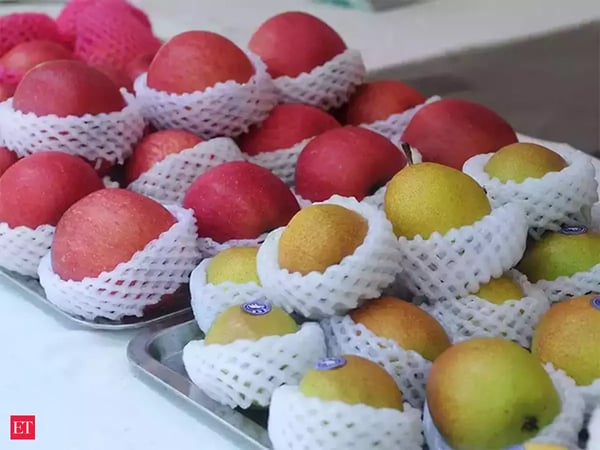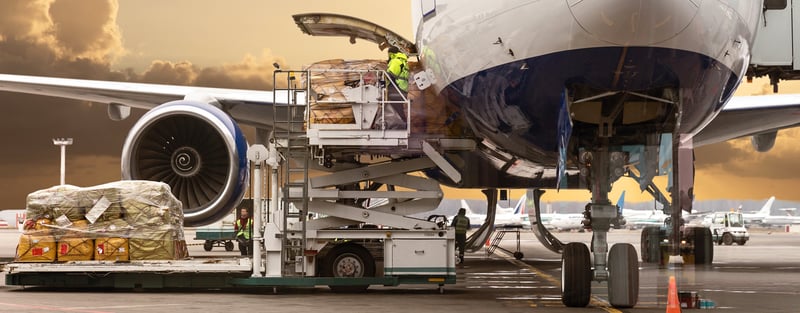Perishable food is any food that has a limited shelf life and requires careful handling and storage to prevent spoilage. Perishable food includes fruits, vegetables, meat, seafood, dairy products, flowers and some pharmaceuticals and cosmetics. Shipping perishable food by air is a fast and reliable way to transport these products across long distances and ensure their freshness and quality.

However, air freight of perishable food also poses many challenges and requires specialised skills and knowledge. In this blog post, we will explore some of the aspects of air freight of perishable food from South America to USA, such as seasonal variations, types of perishables being transported, the source countries, the volumes and the challenges.
Seasonal variations
One of the main factors that affects the demand and supply of perishable food is seasonality. Different products have different harvesting seasons and peak periods of consumption. For example, mangoes are harvested in South America from October to February, while blueberries are harvested from November to March. These products are in high demand in the USA during winter, when local production is low or nonexistent.
Therefore, air freight of perishable food from South America to USA tends to increase during the winter months, when there is a higher demand for fresh and exotic fruits and vegetables in the northern hemisphere. Conversely, air freight of perishable food from USA to South America tends to increase during the summer months, when there is a higher demand for meat, dairy products and flowers in the southern hemisphere.
Types of perishables being transported

The types of perishables being transported by air from South America to USA vary depending on the availability, demand and preferences of each product. However, some of the most common types are:
- Fruits: such as mangoes, avocados, berries, grapes, citrus fruits, bananas and pineapples.
- Vegetables: such as asparagus, broccoli, cauliflower, carrots, lettuce and peppers.
- Flowers: such as roses, carnations, orchids, lilies and tropical flowers.
- Meat: such as beef, pork, lamb and poultry.
- Seafood: such as shrimp, lobster, crab, salmon and tuna.
- Dairy products: such as cheese, yogurt and butter.
- Pharmaceuticals: such as vaccines, insulin and blood products.
- Cosmetics: such as creams, lotions and perfumes.
South America is a diverse continent with many countries that produce and export different types of perishable food. Some of the main source countries for air freight of perishable food from South America to USA are:
- Brazil: the largest producer and exporter of fruits in South America, especially citrus fruits, mangoes and grapes. Brazil also exports meat, poultry and dairy products to the USA.
- Chile: the second largest producer and exporter of fruits in South America, especially berries, cherries and grapes. Chile also exports seafood, wine and flowers to the USA.
- Colombia: the third largest producer and exporter of fruits in South America, especially bananas, pineapples and avocados. Colombia also exports flowers, coffee and cosmetics to the USA.
- Peru: the fourth largest producer and exporter of fruits in South America, especially asparagus, grapes and avocados. Peru also exports seafood, quinoa and organic products to the USA.
- Ecuador: the fifth largest producer and exporter of fruits in South America, especially bananas, pineapples and passion fruit. Ecuador also exports flowers, cocoa and shrimp to the USA.

The volumes
According to IATA (International Air Transport Association), air cargo accounts for less than 1% of global trade by volume but more than 35% by value. This means that air cargo is mainly used for high-value or time-sensitive goods that require fast delivery. Perishable food falls into this category.
However, air freight of perishable food is still a small fraction of total air cargo volume. According to IATA data for 2019 (the latest available), perishable cargo represented only 8% of total international air cargo volume (in tonnes) and 11% of total international air cargo revenue (in USD).

The volume of air freight of perishable food from South America to USA varies depending on the type of product, the seasonality and the market conditions. However, some estimates based on IATA data for 2019 are:
- Fruits: about 200,000 tonnes per year
- Vegetables: about 50,000 tonnes per year
- Flowers: about 40,000 tonnes per year
- Meat: about 30,000 tonnes per year
- Seafood: about 20,000 tonnes per year
- Dairy products: about 10,000 tonnes per year
- Pharmaceuticals: about 5,000 tonnes per year
- Cosmetics: about 2,000 tonnes per year
Shipping perishable food by air is not an easy task. It requires careful planning, coordination and execution to ensure the safety, quality and integrity of the products throughout the supply chain. Some of the main challenges are:
- Temperature control: Perishable food needs to be kept at a specific temperature range to prevent spoilage, contamination or damage. This requires the use of refrigerated containers, trucks, warehouses and aircrafts, as well as temperature monitoring devices and systems.
- Packaging: Perishable food needs to be packed in a way that protects it from physical shocks, moisture, pests and odours. This requires the use of appropriate materials, such as cardboard boxes, plastic bags, foam pads and ice packs.
- Labelling: Perishable food needs to be labelled with clear and accurate information, such as product name, origin, destination, quantity, weight, expiration date and handling instructions. This requires the use of standardized codes, such as barcodes, QR codes and RFID tags.
- Documentation: Perishable food needs to comply with various regulations and requirements, such as customs clearance, sanitary inspection, phytosanitary certification and import permits. This requires the preparation and submission of various documents, such as invoices, packing lists, air waybills and certificates of origin.
- Logistics: Perishable food needs to be transported in a timely and efficient manner, avoiding delays, disruptions or losses. This requires the coordination and optimization of various modes of transportation, such as trucks, trains, ships and planes.
Air freight of perishable food from South America to USA is a complex and dynamic process that involves many actors and factors. It is also a valuable and growing market that offers many opportunities and benefits for both producers and consumers.
However, it also poses many challenges and risks that need to be addressed and overcome. In this blog post, we have provided an overview of some of the aspects of air freight of perishable food from South America to USA, such as seasonal variations, types of perishables being transported, the source countries, the volumes and the challenges.
We hope you have found this information interesting and informative for the airfreight industry.

